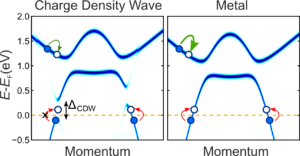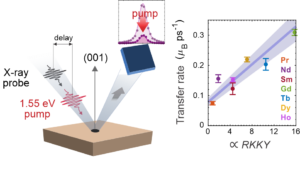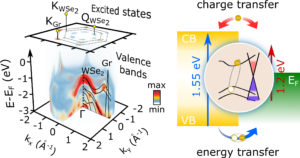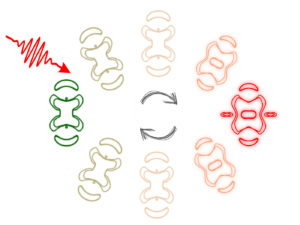Home
Welcome to the Dynamics of Correlated Materials group!
We are an experimental research group focusing on the investigation of ultrafast processes in strongly correlated materials. Our goal is the understanding of the fundamental interactions at play on the microscopic level in such materials, leading to complex behavior. We develop and employ complementary ultrafast techniques such as time- and angle-resolved photoelectron spectroscopy (trARPES) and time-resolved diffraction techniques to study those elementary interaction processes and couplings across ultrafast phase transitions.
News
Paper published: Coherent Modulation of Quasiparticle Scattering Rates in a Photoexcited Charge-Density-Wave System
Jan 2022

In our recent combined experimental and theoretical study [Maklar et al., Phys. Rev. Lett. 128, 026406 (2022)], we investigate how a dynamical insulator-to-metal transition affects fundamental interactions, such as electron-electron and electron-phonon scattering. We utilize optical excitation to transiently alter the energy gap of a charge-density-wave compound and observe a concurrent, highly unusual modulation of the relaxation rate of hot quasiparticles. State-of-the-art calculations based on non-equilibrium Green’s functions provide a microscopic view onto the interplay of quasiparticle scattering and the transiently modified electronic band structure, highlighting the critical role of the phase space of electron-electron interaction. Our results vividly demonstrate the possibility of controlling quasiparticle relaxation rates [more...]
New preprint: Exchange scaling of ultrafast angular momentum transfer in 4f antiferromagnets
Sep 2021

When photoexcited by an ultrafast laser pulse, antiferromagnets allow direct angular momentum transfer between opposing spins, promising faster functionality than ferromagnets, which are intrinsically limited because their net angular momentum must dissipate to the lattice. The process of angular momentum transfer is closely linked to the nature of magnetic coupling in the system. In lanthanides, 4f magnetic exchange is mediated indirectly through the conduction electrons (the Ruderman–Kittel–Kasuya–Yosida interaction, RKKY), and the effect of such conditions on the antiferromagnetic direct spin transfer is largely unexplored.
In our study we used resonant ultrafast X-ray diffraction to study ultrafast magnetization dynamics in a series of 4f antiferromagnets, and systematically varied the 4f [more...]
In our study we used resonant ultrafast X-ray diffraction to study ultrafast magnetization dynamics in a series of 4f antiferromagnets, and systematically varied the 4f [more...]
New Preprint: Observation of interfacial Meitner-Auger energy transfer
Aug 2021

Interlayer charge- and energy transfer processes in atomically thin, layered van der Waals heterostructures are of fundamental importance for determining their properties in novel device concepts based on single active crystalline layers. In our recent preprint (arXiv link) we study the ultrafast excitation, relaxation and transfer processes in an epitaxial grown monolayer WSe2/graphene heterostructure using time- and angle-resolved photoemission spectroscopy. By measuring the non-equilibrium electronic structure, we identify a novel interfacial energy transfer mechanism: Meitner-Auger energy transfer, which describes the conversion of an exciton in the semiconductor to an intraband electron-hole pair in graphene, characterized by the excitation of deep-lying valence holes [more...]
Paper Published: Nonequilibrium Charge-Density-Wave Order Beyond the Thermal Limit
May 2021

Phase transitions under quasi-equilibrium conditions, e.g., induced by a slow variation of temperature, are well described by Landau theory. In contrast, the situation far from equilibrium, e.g., after ultrafast laser excitation, differs fundamentally from a thermodynamic scenario, and it remains an open question how our understanding of static phase transitions in complex matter has to be adapted to capture a dynamical, photoinduced melting and recovery of order. In particular, even the thermal critical temperature might not provide a valid description in a system exhibiting strong non-equilibrium between different degrees of freedom, such as electrons and lattice.
In our study which was published in Nature Communications, we investigate an ultrafast charge-density-wave-to-metal transition after optical excitation by combining state-of-the-art time-resolved electronic and structural [more...]
In our study which was published in Nature Communications, we investigate an ultrafast charge-density-wave-to-metal transition after optical excitation by combining state-of-the-art time-resolved electronic and structural [more...]
New paper: Ultrafast modulation of a material's Fermi surface topology
Apr 2021

The transport of electrons is governed by the shape of the Fermi surface. We found that the topology of the Fermi surface of a semimetal can be manipulated on ultrafast timescales through optical excitation. A change in the Fermi surface topology, also called Lifshitz transition, can lead to the emergence of fascinating phenomena like colossal magnetoresistance and superconductivity. Combining time-resolved multidimensional photoemission spectroscopy and TDDFT+U simulations, we introduce a scheme for driving an ultrafast Lifshitz transition in the correlated type-II Weyl semimetal Td-MoTe2. We show that this non-equilibrium topological transition finds its microscopic origin in the dynamical modification of the electronic correlations.
Beaulieu et al., Science Advances 7, eabd9275 (2021). Link [more...]
Beaulieu et al., Science Advances 7, eabd9275 (2021). Link [more...]